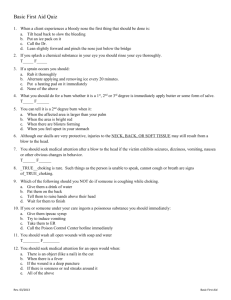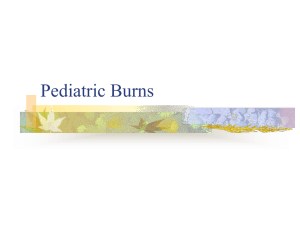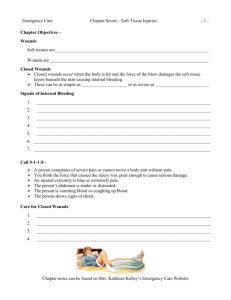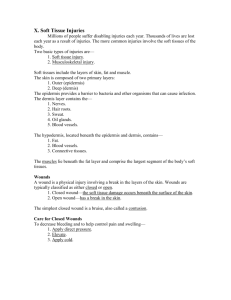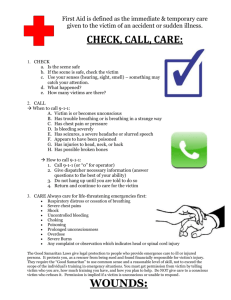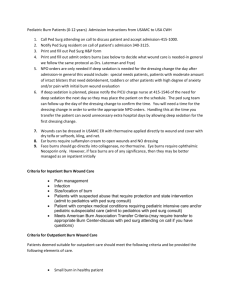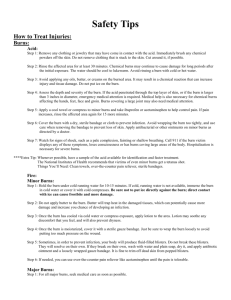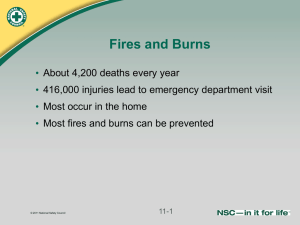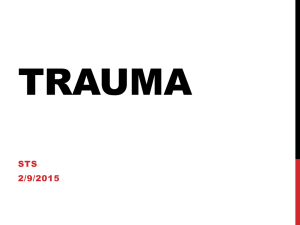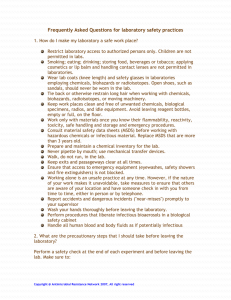CH 12 – Specific Injuries
advertisement
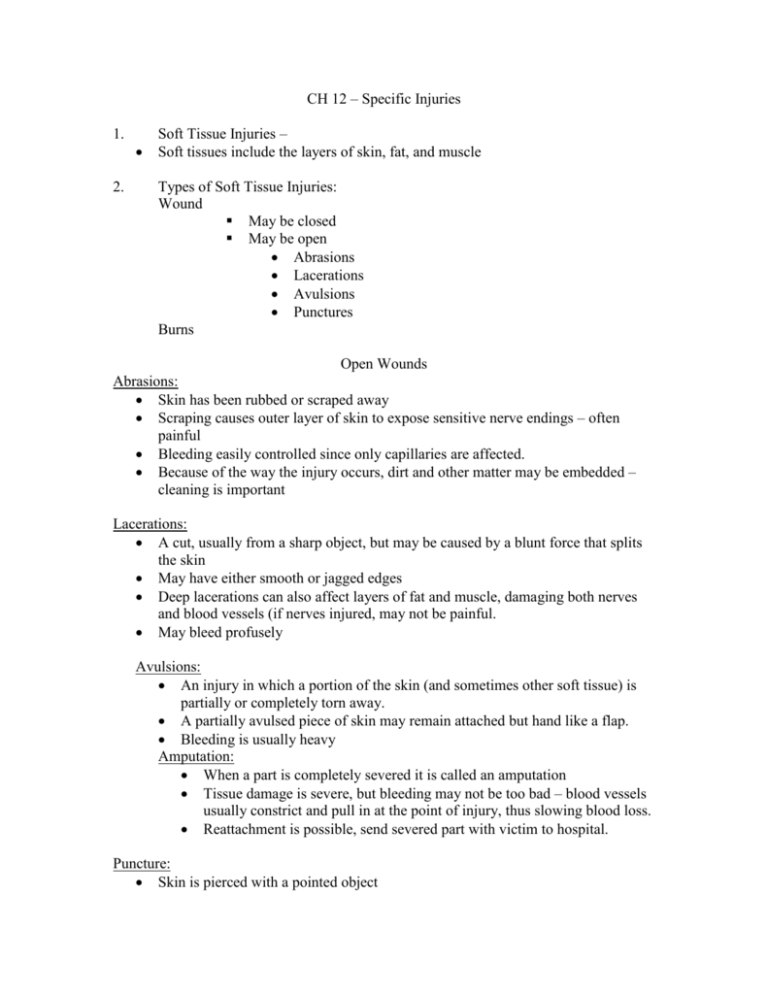
CH 12 – Specific Injuries 1. 2. Soft Tissue Injuries – Soft tissues include the layers of skin, fat, and muscle Types of Soft Tissue Injuries: Wound May be closed May be open Abrasions Lacerations Avulsions Punctures Burns Open Wounds Abrasions: Skin has been rubbed or scraped away Scraping causes outer layer of skin to expose sensitive nerve endings – often painful Bleeding easily controlled since only capillaries are affected. Because of the way the injury occurs, dirt and other matter may be embedded – cleaning is important Lacerations: A cut, usually from a sharp object, but may be caused by a blunt force that splits the skin May have either smooth or jagged edges Deep lacerations can also affect layers of fat and muscle, damaging both nerves and blood vessels (if nerves injured, may not be painful. May bleed profusely Avulsions: An injury in which a portion of the skin (and sometimes other soft tissue) is partially or completely torn away. A partially avulsed piece of skin may remain attached but hand like a flap. Bleeding is usually heavy Amputation: When a part is completely severed it is called an amputation Tissue damage is severe, but bleeding may not be too bad – blood vessels usually constrict and pull in at the point of injury, thus slowing blood loss. Reattachment is possible, send severed part with victim to hospital. Puncture: Skin is pierced with a pointed object Bleeding not usually severe since skin closes around the wound. Become infected easily – the object may have microorganisms – tetanus is a big concern. Internal bleeding can be severe if the penetrating object damages major blood vessels or internal organs. Embedded objects- an object remains in the wound Object may pass through a body part, making two open wounds. Dressings & Bandages – Dressing: pads placed directly on the wound most are porous to allow air to circulate universal dressings – much larger dressings to cover large wounds occlusive dressing – does not allow air to pass Bandages: any material used to wrap or cover any part of the body hold dressings in place Pressure bandage - a bandage applied snugly to create pressure on a wound. Bandage compress – a thick gauze dressing attached to a gauze bandage – it can be tied in place and is used with severe bleeding Roller bandage Elastic bandage Triangular bandage can be folded into a cravat INFECTION SIGNS & SYMPTOMS: area around the wound is swollen & red pus discharge fever & feeling ill red streaks develop area feels warm & throbs with pain CARE: keep area around the wound clean apply warm, wet compress & antibiotic ointment apply a dressing & bandage - change it daily seek medical care if victim's condition worsens BURNS -caused by heat, chemicals, electricity, solar or other forms of radiation. 1. Severity of burn depends upon: a. Temp. of object or gas causing the burn b. c. d. e. Length of exposure to source Location of burn Extent of the burn Victim's age & medical condition 2. Types: classified by cause & depth a. Superficial (1st degree) -SKIN RED AND DRY -affects epidermis -pain -may swell -heals in 5-6 days b. Partial thickness burns (2nd degree) -affects epidermis & dermis -red -BLISTERS - may or may not be open -may look spotted or blotchy -PAIN -may swell -heal in 3-4 weeks c. Full thickness burns (3rd degree) -both layers of skin as well as any or all of the fat, muscles, bones, & nerves destroyed. -LOOK BROWN OR CHARRED -tissues underneath may look white -very painful or no pain -life-threatening -shock -scaring - may require skin grafts CRITICAL BURNS 1. 2. 3. 4. 5. 6. Victim is having breathing difficulty Burns covering more than one body part Burns to head, neck, hands, feet, or genitals Any partial thickness or full thickness burn to a child or an elderly person (age 60+) Burns caused by chemicals, explosions, or electricity. Suspected burns to the airway. Special concerns: o Victims under 5 or over 60 o Hot grease o Clothing that has hot liquids or flames – slow to cool o Melted fabrics Estimating the Extent of Burns The rule of 9’s is used to estimate how much of the body is burned Head = 9% Front = 18% Back = 18% Left arm = 9% Right arm = 9% Groin = 1 % Left leg = 9% Right leg = 9% % body burned CARE FOR MINOR BURNS 1. Cool the burned area to stop the burning (If the burn is caused by hot tar, cool the area with water, but do not attempt to remove the tar.) 2. Do an initial assessment – especially the victim’s airway 3. Cover the burned area. 4. Minimize shock 5. Prevent infection. 4. Minimize shock - maintain body temperature. Care for SEVERE burns 1. 2. 3. 4. 5. Cover the burn Have the victim lie down Elevate the injured part Maintain body temperature EMS DON'TS FOR BURN CARE 1. 2. 3. 4. 5. 6. apply ice directly to partial or full thickness burns touch burns with anything except sterile or clean dressings use absorbent cotton or pull clothes over any burned area remove pieces of cloth that stick to a burned area try to clean a full-thickness burn break blisters 7. use any kinds of grease or ointment on severe burns Electrical Burns Suspect a possible electrical injury if you hear a sudden pop or bang and/or see an unexpected flash -burns are often deep -victim will have both an entrance and an exit wound. -do not cool with water, just cover -heart may beat erratically or stop (Lightning - p. 257) CARE FOR ELECTRICAL BURNS - CHECK to ensure that the scene is safe CHECK for life-threatening conditions CHECK for two burn sites CARE for shock CHEMICAL BURNS - will continue to burn as long as it is on the skin. First aid: -flush with large amount of cool, running water -if dry chemicals, brush off with gloved hand. -have victim remove contaminated clothes -minimize shock -if eye is burned, continue flushing until EMS arrives or at least 20 minutes. RADIATION BURNS o Similar to heat burns in symptoms o Treat as other thermal burns, but stay out of the sun. Infant and Child considerations: o Need extra care since have greater body-surface area relative to total size –so lose more fluid and heat o Are at extra risks for shock, airway difficulties and hypothermia o Maintain body heat o May use cool water, but do not douse them o Think about child abuse Chest Injuries Signs & Symptoms: Breathing difficulty Severe pain that increases with deep breathing or movement Obvious deformity Bruising Flushed, pale, ashen, or bluish discoloration of skin Coughing up blood Types of Chest Injuries: 1Rib Fractures o Most not life-threatening o Shallow breathing o Will lean toward side of fracture o Flail chest occurs when multiple ribs fractured and produce a lose section First aid for rib fractures o Have the victim rest in a position that makes breathing easier o Bind the arm to the injured side o Be very aware of shock 2 – Puncture Injuries o Can be minor or very serious – stab to gun shot wounds o May penetrate the rib cage and allow air to enter the chest through the wound – sucking chest wound First aid o Apply an occlusive dressing Injuries to the Abdomen o Easily injured since most not protected by skeletal system o Three organs are easily injured: 1. Liver – upper right quadrant of abdomen; easily damaged; bleeding can be severe and quickly fatal; may also leak bile which causes infection 2. Spleen – upper left quadrant of abdomen and behind the stomach; easily damaged; can be severe and quickly fatal 3. Stomach – can bleed severely and food contents may empty into abdomen Signs & Symptoms of Serious Abdominal Injury: o Severe pain o Bruising o External bleeding o Nausea & vomiting (sometimes blood in vomit) o Pale or ashen, moist skin o Weakness o Thirst o Pain, tenderness, rigid abdomen o Organs protruding from abdomen Care for Serious Abdominal Injury Open wound: o Call EMS o position victim on his/her back o do NOT put pressure on protruding organs or try to put them back in o remove clothing around the wound o cover the wound loosely with moist, clean dressing o cover with plastic wrap o cover with folded towel to maintain warmth o CARE for shock o Administer oxygen if available Closed Wound: o Carefully place victim on back o Do not apply direct pressure o Bend the knees slightly – place rolled-up blankets under knees o Administer oxygen o minimize shock o summon more advanced help o o o o Embedded Objects Do not remove objects lodged in eye, ear, or nose May remove an object through the cheek since may cause bleeding problems as blood goes down the throat May remove if it will interfere with chest compressions Control bleeding by bandaging the dressing in place around the object Injuries Causes: 76% of all injures are caused by mechanical energy. There are four types of forces: o Direct - object strikes the body & causes injury at point of impact o Indirect - force travels through the body & causes injury to body part away from the point of impact o Twisting - one part of the body stays in one position while another part of the body turns. o Contracting - sudden or powerful muscle contractions Factors affecting injury: 1. Injury is the leading cause of death in people 1-37. 2. Higher among people under 45 3. Highest rate of deaths from injury occur in elderly and people 15-24 4. Males are at greater risk for any type of injury and 2 ½ times as likely to die from injury 5. Three of four deaths and over half of the injuries occurred off the job. Injury Prevention: o Persuade people to alter risky behavior o Require behavior change by law and regulation o Provide automatic protection through product and environmental design
